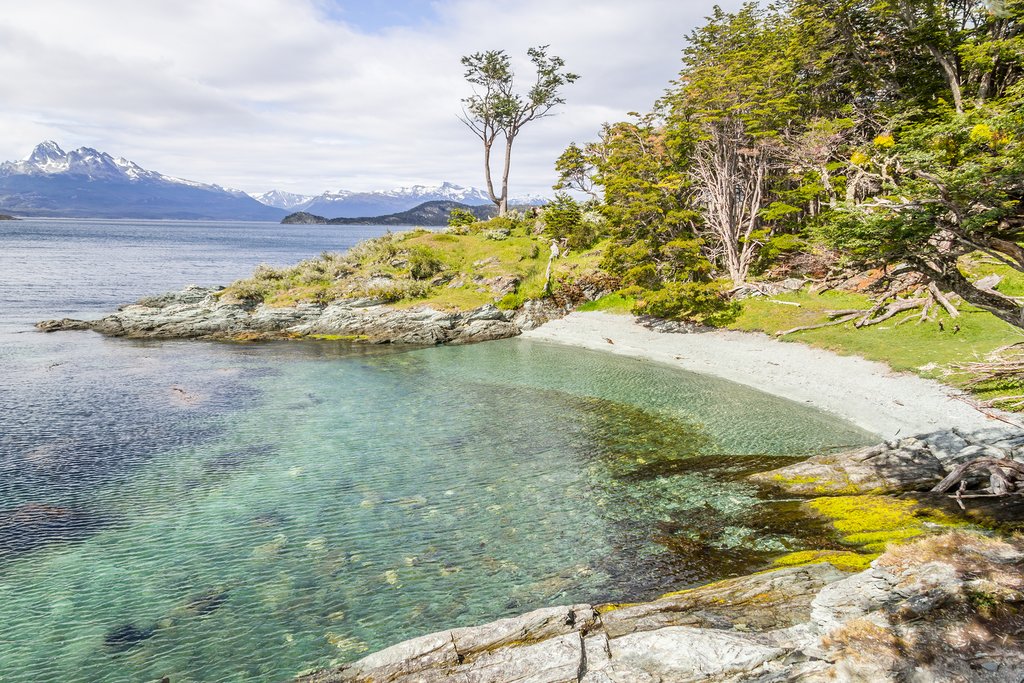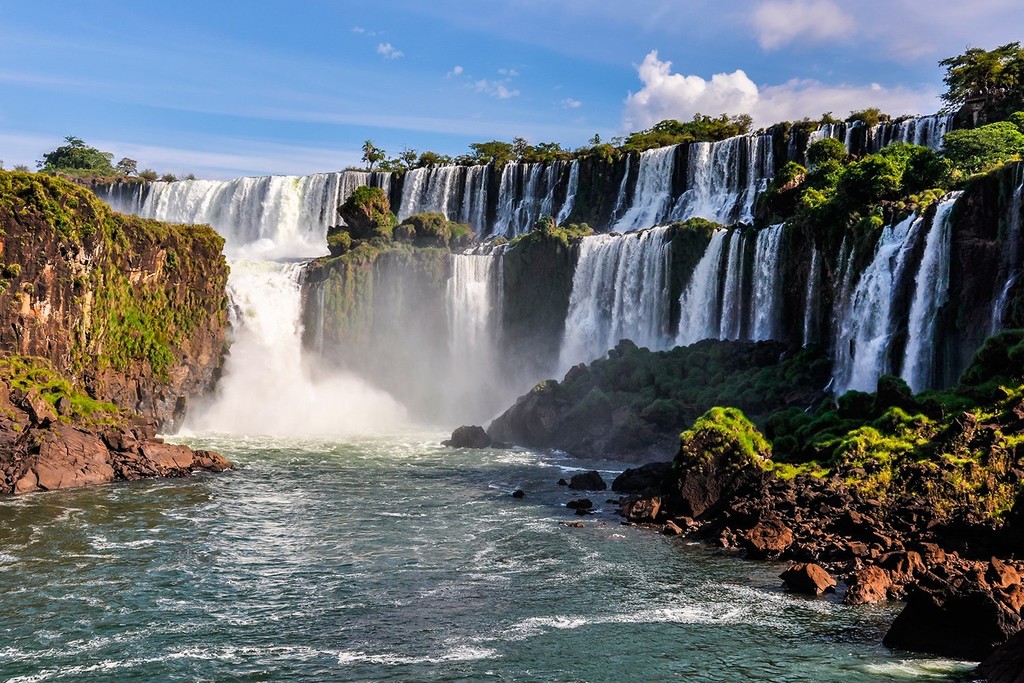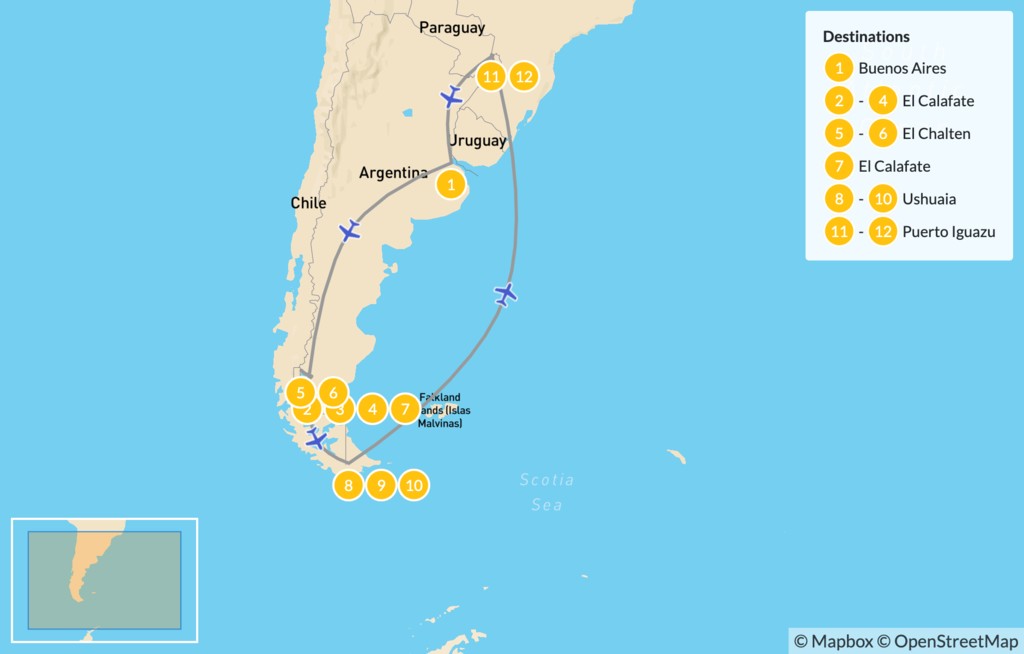Highlights
- Kick off the trip with a free day in Buenos Aires
- Take a scenic boat ride up to the Perito Moreno glacier
- Choose your own hiking route up the iconic Mt. Fitz Roy
- Spot marine wildlife while cruising the Beagle Channel
- Hike to a stunning Iguazú Falls viewpoint
Brief Itinerary
| Day | Highlights | Overnight |
|---|---|---|
| Day 1 | Explore Buenos Aires | Buenos Aires |
| Day 2 | Fly from Buenos Aires to El Calafate | El Calafate |
| Day 3 | Discover Los Glaciares National Park | El Calafate |
| Day 4 | Free Day in El Calafate | El Calafate |
| Day 5 | Transfer from El Calafate to El Chaltén | El Chalten |
| Day 6 | Self-Guided Hiking in El Chaltén | El Chalten |
| Day 7 | El Chaltén to El Calafate | El Calafate |
| Day 8 | Fly from El Calafate to Ushuaia - Explore the City | Ushuaia |
| Day 9 | Hiking & Canoeing in Tierra del Fuego | Ushuaia |
| Day 10 | Beagle Channel Cruise | Ushuaia |
| Day 11 | Fly from Ushuaia to Iguazú | Puerto Iguazu |
| Day 12 | Explore Iguazú Falls (Argentine Side) | Puerto Iguazu |
| Day 13 | Buenos Aires Departure |
Detailed Itinerary
Day 1: Explore Buenos Aires

Welcome to Argentina! Renowned as the "Paris of South America" and the "Queen of El Plata", the capital city of Buenos Aires is famous for its mix of European ambiance and Latin American zest for life. The birthplace of Argentina's rich tango heritage, home to some of the most beautiful architecture and the richest museums, and the nucleus of its fútbol (soccer) culture—a sport for which Argentinians have unbridled enthusiasm.
When you arrive at the airport—most likely Ezeiza International—your driver will take you to your hotel where you will have the chance to recharge from the journey. Once you're rested up, be sure to venture out into the welcoming arms of Buenos Aires and explore. The city center is your best starting point.
Suggested activities include:
- Admire Plaza de Mayo, the city's oldest and most important square, and a site of both celebrations and protests. The plaza is ringed by ornate government buildings, the Metropolitan Cathedral, and the 1580 town hall. In the middle of the landscaped plaza, the Pirámide de Mayo was built in 1811 as a monument to the May Revolution of 1810, which gave the nation independence from Spain.
- Visit the Obelisco, which might be the most famous landmark in the city. Erected in 1936, the stone obelisk commemorates the 400th anniversary of the city's founding. Sitting right in the middle of Avenida 9 de Julio, and boasting a whopping 16 lanes, makes it the widest city street in the world.
- Stop by the Teatro Colon, one of South America's premier opera houses. The horseshoe-shaped gallery features 2,487 seats and incredible acoustics. You can take a tour through the incredibly elaborate opera house or watch a show here. The Colon's stunning neoclassical facade has been regarded as one of the most beautiful buildings in Buenos Aires since its opening in 1908.
- Stroll through Puerto Madero, an upscale waterfront neighborhood adjacent to Buenos Aires' downtown. Puerto Madero is known as the "new money" financial center of Buenos Aires. There is a lively walking route worth exploring and a canal lined with bars and restaurants. Enjoy a romantic stroll over the canal on the Puente de la Mujer at sunset—the innovative, modern footbridge swings open to allow boat traffic to pass.
- Dine at an Argentine steakhouse, or parilla. When dinnertime arrives, enjoy an authentic thick, juicy steak— Argentina has some of the best beef in the world— drizzled with the nation's famous chimichurri (a garlic, herb, and vinegar sauce). Plan on dining late—Buenos Aires' culture thrives after dark, and it's common to have dinner after 9 pm, especially on weekends.
Day 2: Fly from Buenos Aires to El Calafate

In the morning, a driver will meet you at your hotel and take you to the airport for your flight to El Calafate. Known as the gateway to Argentina's glaciers, the city is located on the shores of Lago Argentino, the nation's biggest freshwater lake. If possible, select a window seat to enjoy the stunning views of the Southern Patagonian Ice Field as you fly over it.
Upon arrival at El Calafate, another transfer will take you to your hotel. You can spend the rest of the day relaxing or wander around and enjoy the quaint cafés and souvenir shops around town. You can learn about nearby glaciers by visiting the Glaciarium, a multi-media center that has an ice museum, various interactive displays, and educational information regarding glaciers. Don a coat, boots, and gloves to enjoy a drink at the museum's Glaciobar BrancaIt, Argentina's first ice bar.
Day 3: Discover Los Glaciares National Park

After breakfast, head to Los Glaciares National Park. As you enter this protected area, you will catch your first glimpse of the majestic Perito Moreno. This expansive glacier flows down from the Andes over the turquoise waters of Lago Argentino, and ends abruptly in a great wall of ice that curves around the lake. You may also witness "calving"—the awe-inspiring sight of ice breaking off the facade and crashing into the tranquil waters below. Every time ice hits the water, a thundering crash echoes around the lake.
Perito Moreno is not the only glacier in the area, but it is the most famous in the park. It is one of the few advancing glaciers in the world, which is what causes the calving. Upon arrival, you can admire Perito Moreno from a number of different vantage points, thanks to the network of wooden walkways positioned in front of the glacier. You will also get the chance to see the massive ice wall up close on a boat tour.
After a day spent viewing the glacier and wandering the numerous trails, head back to El Calafate to enjoy the evening at your leisure.
Day 4: Free Day in El Calafate

Today, you have a free day to explore El Calafate. Arrange a spa treatment at a resort or head out and find more adventures in and around El Calafate, such as horseback riding on a ranch or joining a kayaking tour.
For a break from the glaciers, you can also take a short 15-minute walk from El Calafate to the Reserva Laguna Nimez ecological reserve. This protected area is a haven for a great variety of birds, including the Chilean flamingo. A self-guided walk takes visitors around the whole reserve on the boardwalk .
Besides the Glaciarium, you can visit the town's history museum: Centro de Interpretación Histórica. Covering the history of Patagonia since the Ice Age, the museum offers useful information on glaciers, as well as dinosaurs, extinct animals, Indigenous Peoples, and the formation of other geographical landscapes.
Day 5: Transfer from El Calafate to El Chaltén

After breakfast, a vehicle will pick you up for the three-hour drive to the town of El Chaltén. If the skies are clear, you'll be treated to incredible views of Mt. Fitz Roy, the toothlike 11,020-foot (3,359-meter) granite mountain that looms over the town. El Chaltén is regarded as a hikers paradise due to the proximity of Fitz Roy and other mountaineering options in the area.
Upon arrival, you'll check into your hotel and have the rest of the day to acclimate to the area. Perhaps you'll want to take a walk in town before a relaxing evening sampling El Chaltén's many restaurants and craft-beer bars.
Chat with a local specialist who can help organize your trip.
Day 6: Self-Guided Hiking in El Chaltén

Today is yours to enjoy. You can easily take a self-guided tour and choose from a variety of trails without fear of getting lost since all the paths are clearly marked and well-maintained.
If you have the energy, you can opt for a "day hike," which can last up to 11 hours depending on the route you choose. Trails lead from town up through alpine forests and feature a diverse range of landscapes. One of the most popular full-day treks is to Laguna de los Tres, offering rewarding views of Mount Fitz Roy and its Aguja Poincenot granite spire.
There are easier trails, too. You can head out on a short, 1.9-mile walk through lenga forests and along the Rio de las Vueltas. This option allows you to see various endemic birds, such as woodpeckers. For even more mountain views, head to the Cerro Torre lookout. Or set out on a two-hour brisk hike amid the native forest to a lagoon with deep blue waters. This is Laguna Capri, a lake that sits at the foot of the mountains with unobstructed views of the Fitz Roy massif.
In the evening, after a day spent enjoying nature, you'll return to your hotel in time to enjoy a leisurely dinner and a nightcap in El Chaltén.
Day 7: El Chaltén to El Calafate

After breakfast, you'll take a three-hour private transfer to reach El Calafate. Upon checking into your hotel, you can then spend the afternoon exploring the town and its surroundings.
Browse the local shops and enjoy the cafés, and be sure to sample the local cuisine like roast Patagonian lamb and Argentine staples like rib-eye steak and empanadas. You'll want to wash it all down with a great glass or two of Malbec from the Mendoza wine region.
Day 8: Fly from El Calafate to Ushuaia - Explore the City

After breakfast in El Calafate, you'll pack up and transfer to the airport for your flight to Ushuaia, the southernmost city in the world. Upon arrival, a driver will meet you at the airport and transfer you to your hotel where you'll have the rest of the day to explore as you see fit.
Located on a bay in the Patagonian region of Tierra del Fuego, Ushuaia sits between the jagged peaks of the Martial Mountains and the silver waters of the Beagle Channel. This is the same waterway Charles Darwin explored when he was traveling on the HMS Beagle almost 200 years ago. Make sure to get out and walk along the waterfront for a better glimpse of the craggy mountains and wide channel.
Suggested activities in and around town:
-
Stroll the streets of downtown. As you walk around the colorful shops and buildings, notice an endearing jumble of architectural styles with everything from mock chalets to tumbledown wooden cottages.
-
Stop in at the Prison Museum. The building that houses Ushuaia's Maritime Museum was once an old prison. Constructed at the turn of the 20th century, some 600 convicts occupied 380 cells until the prison's closing in 1947. Today, the prison looks unchanged since its doors closed.
-
Visit the Museo del Fin del Mundo, or "End of the World" Museum. Located on the waterfront, this small museum features fascinating exhibits on the region's natural and indigenous history. You'll also find extensive exhibits on birds and sailing.
-
Head to Laguna Esmeralda. With the trailhead about 11 miles (17 km) outside of Ushuaia, this is an easy afternoon hike for all levels. The shores of this turquoise lake are great for photos and stopping to enjoy nature.
- Sample the local cuisine. The region is famous for its seafood, particularly centolla (king crab). Try it au gratin—it's the most decadent dish in Ushuaia.
Day 9: Hiking & Canoeing in Tierra del Fuego

Spend a day in Tierra del Fuego National Park, one of the most frequently visited places around Ushuaia. It's located just outside the city, and there are many wonders within its 155,000 acres. During this excursion, you'll be accompanied by an expert guide to help you around this protected paradise, from seaside mountains and freshwater rivers to subantarctic forests and tranquil bays.
After arriving in the park, you'll enjoy a 4.3 mile (7 km) hike on a coastal path that follows the Beagle Channel. You will have prime views of the channel along the way plus the chance to enjoy the diverse flora and fauna, which includes sea-lions, seals, and albatrosses. During the hike, you'll also pass remnants of ancient settlements once occupied by the Yámana indigenous people.
You'll reach Lago Roca after trekking for three hours. Here you can relax and enjoy a hot lunch before pushing off on a canoe ride down the Lapataia River. This waterway leads to your ultimate destination—the spectacular Bahia Lapataia (Lapataia Bay)—located in the Beagle Channel, sitting at the end of Nacional Route No. 3, an extension of the legendary Pan American Highway. From here, you'll transfer back to your hotel in Ushuaia.
Day 10: Beagle Channel Cruise

After breakfast in Ushuaia, you'll head to the pier to board a boat for a local cruise. Today's excursion sails along the Beagle Channel, one of the region’s most important waterways named after the HMS Beagle, a 19th-century British ship that brought Charles Darwin to South America.
As you pass through the channel, you'll witness breathtaking views of Ushuaia and the mountains behind it. Be on the lookout for diverse marine wildlife such as cormorants and sea lions, especially near the Lobo and De Los Pajaros islands. If the winds are calm, you can see all the way to the opposite coast, which stretches across Chile and Argentina. Before heading back to Ushuaia, you'll pass by the famous Les Eclaireurs, the "Lighthouse at the End of the World."
Day 11: Fly from Ushuaia to Iguazú

This morning a driver will pick you up from your hotel and transfer you to the airport. You've got a long journey ahead of you. A flight will take you from the rugged forests and icy peaks of southern Patagonia to the mango trees and rainforest jungles of northern Argentina's Misiones Province. Here you'll find the jewel in the crown: Iguazú Falls, the largest waterfall system in the world.
Upon arrival to the city of Puerto Iguazú, you'll check into your hotel and then have the option for a half-day tour of the Brazilian side of Iguazú Falls (as opposed to the Argentine side) beginning in the afternoon. This is a good introduction to the falls, as the Brazilian side offers easily accessible viewpoints where you can enjoy the majesty of this natural wonder without the extensive walking that accompanies a visit to the Argentine side.
So enjoy the falls as you acclimate to the warmer weather (temps here can top 90°F in the summer months). Also, be on the lookout for exotic animals that call the area home, such as monkeys and coatis.
Note: special visas are required for certain countries. Please ask the specialist if it is necessary for your itinerary.
Day 12: Explore Iguazú Falls (Argentine Side)

After breakfast at your hotel, a driver will pick you up and drop you off at the entrance of Iguazú National Park, the Argentine side of the falls. This is where you will begin the day's adventure, a full-day tour that involves walking the three circuits that weave around the falls. Each of these offers different vantage points from which to view the water.
The three circuits include:
- The upper circuit (1 hour) is made up of 2,624 feet (800 m) of walkways elevated above the jungle floor to avoid disrupting the natural paths of indigenous fauna. On this route, you'll see the upper portion of Iguazú, including countless panoramic vistas of the surrounding falls.
- The lower circuit (2 hours) is 5,250 feet (1,600 m) long and is also made up of elevated walkways, which go directly below and around the falls. This circuit takes you near the base of the falls and right up to the crashing torrents of water. You'll be able to feel the magnitude of the falls from up close.
- The Devil's Throat (2 hours) is the star of the show. A small tourist train leaves from the Cataratas Station and travels 18 minutes to Garganta Station, where you'll find restrooms, a snack bar, and the start of the path. You'll walk 3,937 feet (1200 m) over the river until you reach the viewing platform. From there you'll be able to peer 269 feet (82 m) down into the water, as the highest of Iguazu's falls thunders all around you.
At the end of the tour, the driver will pick you up and take you back to your hotel.
Map



